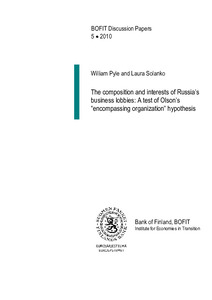The composition and interests of Russia's business lobbies : A test of Olson's "encompassing organization" hypothesis
Pyle, William; Solanko, Laura (24.03.2010)
Numero
5/2010Julkaisija
Bank of Finland
2010
Julkaisun pysyvä osoite on
https://urn.fi/URN:NBN:fi:bof-201408071949Tiivistelmä
Why are some lobby groups less benign in their external effects than others? Nearly three decades ago, Mancur Olson (1982) proposed that less-encompassing lobby groups with their constituents collectively representing a narrow range of sectors are more apt to seek the types of subsidies, tariffs, tax loopholes, and competition-limiting regulations that impose costs on the rest of society. To the best of our knowledge, Olson s oft-cited hypothesis has yet to be actually tested, due perhaps to the absence of adequate data on general policy preferences of various types of lobbies. Thus, we examine a pair of surveys from 2003 and 2004 which were targeted at managers of business associations (lobby groups) and their enterprise constituents to directly test Olson s hypothesis. Managers from a diverse array of Russian industrial firms and business associations were asked similar questions regarding their attitudes to policies that explicitly benefit well-defined sectoral or regional interests and, implicitly, impose external costs. The pattern of responses is striking. Managers of less-encompassing associations and the constituent firms of such groups are much more apt to see such policies in a favorable light. In contrast, more-encompassing associations and their member display greater skepticism toward narrowly targeted government interventions. Our results strongly support Olson s hypothesis.
Julkaisuhuomautus
Published in Public Choice, April 2013, Volume 155, Issue 1-2, pp 19-41
